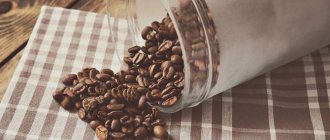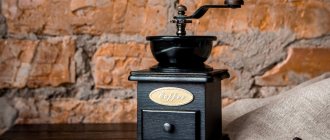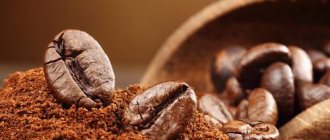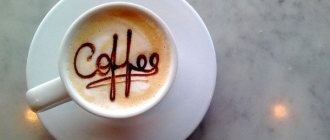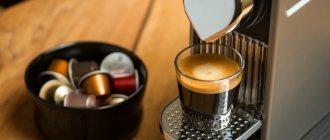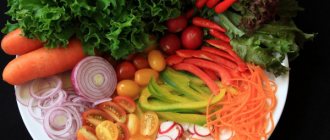Is it possible to make powdered sugar in a coffee grinder?
You can make powdered sugar at home in a coffee grinder, but not in any coffee grinder. If, for example, you have been using a coffee grinder for many years and want to try grinding sugar into powder, but you have lost the instructions a long time ago, it is better not to bother.
There is a high risk of damaging the device by using it for other purposes . And when you go to the store for a new unit, the first place you should look is the instructions.
This is where manufacturers indicate whether it is possible to grind anything other than coffee beans in a coffee grinder. If the device breaks down due to non-compliance with the instructions, you will no longer be able to count on warranty repairs .
Important! The density of sugar crystals is high and the melting point is low, so it should be crushed in pulse mode.
Otherwise, the machine will begin to overheat, the sugar will melt and stick to the knives and millstones.
What not to grind in a coffee grinder
Since there are many “traditional craftsmen” among coffee grinder users, the rotor and chutes of the device often break due to overload and clogging. The latter occurs due to too small fractions, while the culprits of wear of the mechanism can be not only solid products, but also fibrous ones. For example, orange peels and onions often become entangled in the propeller. This leads to the following list of products prohibited for use in a coffee grinder:
- Nutshell;
- Greenery;
- Citrus peel;
- Currant-raspberry branches (for making tea);
- Fish bones.
There are powerful and sophisticated food processors for them. The remaining food components are too tough for the coffee grinder. Although it is better that it serves its intended purpose.
Household appliances Coffee grinder
Recipe
- Before grinding, the coffee grinder should be thoroughly washed and dried with a paper towel . If particles of previously ground products remain on its walls, they will get into the powder and ruin both its appearance and taste. Coffee aromas are absorbed especially quickly.
- Pour the required amount of sugar into the coffee grinder and grind for 1 minute .
- Sift the resulting powder through a fine strainer . This will help remove large sugar crystals.
- Powdered sugar is a hygroscopic product. This means that it quickly absorbs moisture and clumps. Therefore, it should be stored in a glass jar with a tightly screwed lid, at temperatures up to 40 degrees above zero and at a humidity of no more than 75% .
Attention! To prepare powdered sugar, you can use not only a coffee grinder, but also a blender.
What is prohibited from grinding
Regardless of the cost of the device, its power and brand - products that can cause a breakdown. In particular, it is not recommended to use a coffee grinder:
- for nuts and seeds, which, due to their high fat content, will not grind well and leave oil marks on the parts;
- for hard cheeses for the same reason;
- for preparing powdered sugar (with the exception of the manual version);
- for too hard products;
- for stone fruits and berries;
- for raw products.
Important! If a breakdown occurs due to improper use of the coffee grinder, the manufacturer may refuse warranty service.
Ultimately, it is worth remembering that for most culinary purposes there are specialized devices (for spices - mills, for nuts - mortars, etc.) that cope with the task better than universal ones. This also applies to the coffee grinder. Therefore, before using it, you should read the recommendations of the manufacturer itself, which will eliminate the need to contact a service center and extend the life of your kitchen appliances.
What else can you grind besides coffee?
The list of permitted products, to the delight of housewives, is long.
Firstly, it is allowed to grind cereals . It is not always possible to buy chaff in the store, and then a coffee grinder will come to the rescue (for example, a young mother needs the finest grains to prepare baby porridge).
Rice, oatmeal, pearl barley, corn, buckwheat, wheat - all this quickly turns into flour.
Remember! Before the procedure, the cereal should be thoroughly washed in running water and dried. Wet grain sticks to knives and millstones and does not grind well.
Secondly, it is allowed to grind spices : black pepper, chili pepper, cinnamon, cardamom, mustard seeds, dry herbs, dried horseradish root, flax grains, sesame seeds and others. It is ideal to do this in a burr coffee grinder.
To ensure that the grinding is of the highest quality and that the aroma of the spices is fully revealed, before work, heat them in a dry frying pan and cool . The bowl can be filled to one third of the volume or half, but not to the very top.
Thirdly,
it is allowed to grind sea salt (the smaller it is, the faster it dissolves), dried berries, fruit slices, vegetables, cocoa grains , even poppy seeds can be ground in a matter of seconds and without harm to the coffee grinder.
Fourthly, you can grind stale white bread into breadcrumbs . They turn out to be of high quality and are perfect for both cutlets and vegetables.
But there are also exceptions. Here is a list of products that are prohibited from grinding in any coffee grinder :
- All very hard foods , such as fruit seeds and grains. Apple seeds, in principle, will not cause any harm, but cherry pits will cause damage to the device. So be sure to peel all your vegetables and fruits beforehand.
- Dried garlic (especially in devices with a plastic lid). After this, the device cannot be used for grinding coffee beans for a long time.
- Hard cheeses.
- Wet products.
Nutmeg and walnuts are ingredients with a high fat content, so be prepared that you will have a long and tedious time cleaning the coffee maker .
However, they do not pose a danger to the device itself. Like hazelnuts and peanuts. Another controversial product is chocolate. You can grind, but make sure that the device does not overheat.
Attention! Users are advised to purchase and use replacement blades. One is exclusively for coffee and odorless cereals, and the other is for spices.
Only in this case will you be sure that the device will not become saturated with foreign odors and the aroma of the coffee will not be spoiled by anything.
Possible consequences
Using a coffee grinder for other purposes, as a rule, leads to the following consequences:
- Dull knives.
- Damage to the mechanism due to the ingress of liquids, oils and other particles.
- Motor failure due to increased loads.
- The appearance of an odor that is very difficult to eliminate.
- This is interesting: How to grind coffee without a coffee grinder at home
Possible problems are directly related to the type of mechanism. Therefore, for the safety of the device, it is important to understand what can be ground in a coffee grinder, except for coffee, taking into account some features:
- Mechanical – they do not operate on mains power, can be disassembled and cleaned, making them suitable for grinding almost anything.
- Rotary (rotary) – has a lockable container and knives for chopping. In most cases, the grinding is not adjustable.
- Millstone - works on the principle of a mill. The main difference is that it grinds rather than cuts the contents of the container.
Some foods can only be ground in certain types of coffee grinders.
| Manual | Millstone | Rotary | |
| Spices, seeds | + | + | + |
| Salt | + | + | + |
| Sugar | + | + | +/- |
| Hard crackers | + | + | +/- |
| Cereals, legumes | + | + | +/- |
| Oily nuts | + | + | — |
| Dry herbs | + | + | — |
| Chocolate | + | — | + |
| Garlic | + | — | — |
| Vegetables and fruits | + | — | — |
| Mushrooms | + | — | — |
| Hard cheese | + | — | — |
| Greenery | + | — | — |
| Meat fish | — | — | — |
The warranty card usually states that you cannot grind in a coffee grinder. Otherwise, this will void the warranty and in the event of a breakdown you will not be able to count on service support.
Reviews
Below are some reviews. If you have something to say, leave your feedback in the comments below the article, it will be useful to our readers.
Natalia:
I'm a rabid lover of baking, so powdered sugar in the house is a no-brainer. In the end, I decided to splurge on a coffee grinder so as not to endlessly run to the store. I bought an electric ATLANTA ATH-276 for 960 rubles. As a result, I didn’t get powdered sugar, but sugar crushed to grains. It is clearly too large for sprinkling the cake, so this coffee grinder was not up to the task.
Olga:
In our town, powdered sugar can sometimes be hard to find. Therefore, I bought a Moulinex ar1105 stainless steel coffee grinder (with blades). And inexpensive, and grinds sugar into powder, not into crumbs. The main thing is not to let it overheat. By the way, I later found out that this coffee grinder can grind not only sugar and coffee beans, but also nuts, cereals, and other bulk products.
What products is a burr coffee grinder suitable for?
The working part of such a coffee grinder is a set of steel gear-cylindrical millstones, located from each other with some clearance (sometimes in a spiral) and rotating towards each other. Products falling into the gap between the notches are crushed. The size of the particles at the outlet depends on the size of this gap and the speed of rotation of the shafts. Gourmets believe that coffee ground this way tastes better than coffee cut with blender knives. Burr coffee grinders are not cheap, but they cope with many tasks:
- grinding coarse salt (for example, sea salt):
- grinding cereals into flour;
- grinding large hard spices into powder;
- grinding peas, beans and other products to make puree from them.
What this coffee grinder cannot handle is grinding poppy seeds for kutya. And it’s not just about the technical capabilities of the device. Poppy seeds for kutya are ground wet until whitish juice – poppy milk – is released from it, which is contrary to the rules for operating a coffee grinder.
Advice! For these purposes (grinding poppy seeds), it is better to use a mortar and pestle.
Use a mortar to grind poppy seeds
A burr coffee grinder is not intended for grinding wet and juicy products (including poppy seeds for kutya) . Particles of such products have a certain viscosity; they will stick to the teeth of the millstones and clog them. As a result, rubbing parts cannot fully perform their functions, and their wear accelerates.
To completely clean the device from the remnants of such slurry, it will have to be partially disassembled and the parts of the millstones released. A burr coffee grinder is ideal for grinding dry products and only them.
What can you grind in a rotary coffee grinder?
A rotary coffee grinder is a device similar to a blender. It consists of a motor, one or two knives and a coffee container. Enclosed in a plastic or metal case. You press a button and the knives begin to rotate quickly, grinding the grain to a very fine fraction.
What else can you grind in a blade coffee grinder besides coffee:
- dried fruits and vegetables;
- spices;
- cereals (oatmeal or buckwheat);
- crackers;
- flax seeds and sesame seeds;
- some nuts (except walnuts, as they are very fatty).
What you should absolutely not put there:
- rock salt;
- ice;
- durum legumes;
- sugar. When the coffee grinder is running, it heats up, and accordingly, the food inside also heats up. High temperatures can cause sugar to melt and flood internal parts. This will break the device.
What is important to remember when grinding any products in a blade coffee grinder:
- Alternately press and release the button: this way the food will heat up and burn less.
- Carefully remove ground food from a coffee grinder with fixed blades to avoid injury.
- Take out the ground products immediately: the longer they are in the container, the more the coffee grinder becomes saturated with odors.
